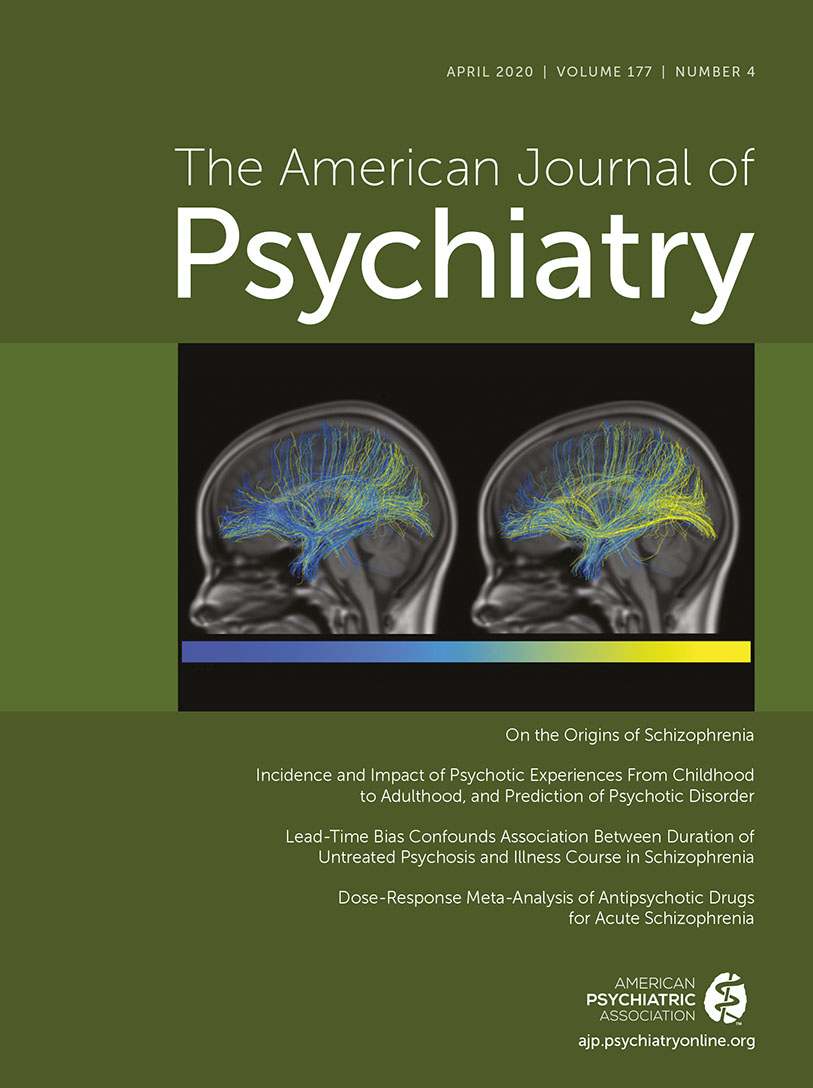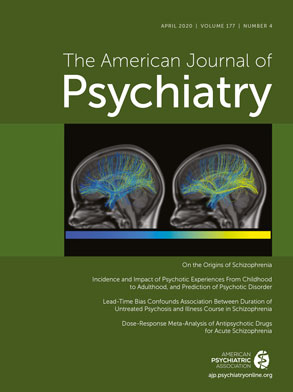Cognitive impairment is a core symptom dimension in schizophrenia: it is common, often severe, and associated with functional impairment (
1). Historically, cognitive impairment in schizophrenia has been thought to be a function of neurodevelopment starting well before illness onset. Studies across illness phases suggest that, at the group level, some degree of cognitive disruption is present prior to diagnosis, becoming more pronounced around the prodrome and first episode, and settling into a new, lower baseline by the time of established illness (
2). However, substantial heterogeneity in cognitive presentation is well described (
3,
4), creating challenges in characterizing cognition and linking cognitive symptoms to neurobiology and clinical outcomes. Given the marked variability in cognition after illness onset, it is likely that cognitive developmental trajectories are also highly heterogeneous. Recent cross-sectional studies of patients in different illness stages using estimates of premorbid and current cognitive functioning have identified empirically derived subgroups of patients with distinct cognitive trajectories (e.g.,
5–
7), suggesting that cognitive course in schizophrenia may not follow a unitary path. Different patterns of brain structure and connectivity have been associated with distinct cognitive subtypes and trajectories (
5,
7–
9), and evidence from two genetic association studies of cognitive subgroups found that genetic markers were differentially associated with cognitive profiles (
10,
11). These findings suggest that variability in cognitive functioning may be leveraged to identify more homogeneous subgroups and trajectories reflecting distinct biological markers.
The identification of genome-wide polygenic risk scores (PRSs) for a variety of constructs ranging from diagnostic classifications (e.g., schizophrenia, attention deficit hyperactivity disorder [ADHD]) to more dimensional features (e.g., cognition, education) based on very large samples has created a set of valuable tools for examination of genetic risk along specific constructs of interest and may provide key information about unique genetic contributions not only to illnesses themselves but to different pathophysiological processes that lead to them. To this end, the article by Dickinson and colleagues in this issue of the
Journal (
12) combines two novel approaches—empirical stratification of cognitive trajectories and examination of multiple polygenic risk indicators (schizophrenia, cognition, ADHD, and education)—to examine distinct cognitive pathways in schizophrenia that may be associated with unique combinations of genetic risk factors.
Three Distinct Pathways
Consistent with other recent cognitive trajectory studies using similar methods (e.g.,
5,
6), the authors found three distinct developmental subtypes in people with schizophrenia: a
preadolescent impairment group characterized by low premorbid and low current IQ; an
adolescent decline group characterized by normative premorbid but low current IQ; and a
cognitively stable group characterized by normative premorbid and normative current IQ. Cognitive subgroups differed in PRS profiles, with the preadolescent impairment group showing unfavorable PRSs in all four domains; the adolescent decline group showing selective risk in schizophrenia and cognition PRSs; and the cognitively stable group showing the most modest schizophrenia risk of the three patient groups (although still elevated relative to control subjects), no other PRS risk indicators, and a more favorable education PRS compared with control subjects. Consistent with these genetic findings, the preadolescent impairment group exhibited higher rates of childhood learning difficulties, lower familial socioeconomic status, and lower educational attainment; symptom levels were generally similar to the other two groups after onset. The adolescent decline group, on the other hand, showed little evidence of childhood difficulties but showed the most severe levels of positive and total psychotic symptoms after onset. Finally, the cognitively stable group showed no evidence of childhood impairment, the highest educational attainment, and the lowest symptom levels when groups differed significantly on measures of symptom severity. These findings reveal genetic risk factors that differ by cognitive subgroup and appear to be reflected in the multivariate phenotypic presentations of three groups: one with more widespread and diffuse genetic risk associated with premorbid and postonset developmental and symptom features; another with more specific genetic risk factors associated with neurodevelopmental abnormalities that have a later onset and present with a stronger positive symptom profile; and a third with “milder” genetic risk for schizophrenia, no additional cognitive or childhood genetic risk indicators, and suggestions of protective factors, including a higher education PRS and higher parental socioeconomic status.
Beyond Diagnoses
Substantial heterogeneity within diagnostic categories has led to increased focus on dimensions as perhaps more closely associated with biomarkers of interest; however, considerable heterogeneity also exists in core symptom dimensions, such as cognitive impairment, hindering our ability to link these symptoms to etiological and neurodevelopmental factors. Characterization of cognitive heterogeneity has advanced our understanding of this complex dimension and its associations with biomarkers. Taking this one step further, it has long been clear that cognitive developmental heterogeneity before and after illness onset is also substantial in schizophrenia, making characterization of not only phenotypes but also trajectories critical, particularly if we are to link dynamic symptoms to more stable etiological factors.
Cognitive and other illness-related factors do not develop in parallel, but are likely dynamically interrelated throughout premorbid, prodromal, and postonset course. For instance, there is evidence of both overlapping and distinct associations between schizophrenia and cognition genetic risk (e.g.,
13,
14), and a recent study using causal modeling found that cognition-related pathways mediate a significant proportion of the influence of genetic risk on schizophrenia (
15), suggesting a dynamic interplay in the developmental processes underlying cognition and schizophrenia pathogenesis. By using multiple PRSs to investigate the interrelationships between genetic risk and phenotypic expression over time, the relative contributions of specific constellations of genetic risk factors to phenotypes from cognition to diagnosis may start to be disentangled and their dynamic associations explored. Characterization of the heterogeneity of cognitive course is then critical (
16), as the study of trajectories may actually move phenotypes closer to their biological underpinnings by estimating not just a snapshot but a
process that might be more closely reflective of the mechanisms driving it. The ability to identify associations between biomarkers and phenotypes requires measuring not only “the right stuff” but measuring it at “the right time,” and perhaps even over time.
Of course, we cannot determine from the Dickinson et al. study the timing or precise course of cognitive involvement, key inflection points, or the direct association between cognitive changes and symptom and functional progression. Longitudinal studies are needed both to validate cognitive subgroups and to replicate associations with genetic, familial, and clinical factors. Additionally, the measures used in the cluster analysis for group selection were somewhat limited in terms of measurement characteristics. While measures of IQ based on abbreviated batteries or word reading tasks are often used as proxies of general intellectual ability, these measures represent rough estimates not designed to carefully characterize cognition in individuals, and they fail to reflect within-subject heterogeneity across dissociable cognitive domains. Single-task or composite measures may blur important distinctions in cognitive profiles—the very construct along which groups are being defined—making the edges between groups less distinct. Additionally, different cognitive domains are believed to be underpinned by at least partially distinct neural systems (e.g.,
17), suggesting that use of broad estimates of cognition to define groups may water down associations between cognitive subgroups and biomarkers of interest. More precise ascertainment of the cognitive variables being used to create meaningful groups administered prospectively may lead to more reliable and valid subgroupings that are more tightly associated with neurobiological variables believed to subserve them.
The Dickinson et al. study reveals the powerful potential of leveraging heterogeneity to identify subgroups of patients along key symptom dimensions and the value of measuring not only constructs but also pathways over time, which may reflect distinct pathophysiologies closer to the biological markers and mechanisms of interest. This work represents a major step forward in the use of empirical stratification and the utility of such approaches in the application of genetic and other biomarkers to heterogeneous illnesses and illness dimensions.

